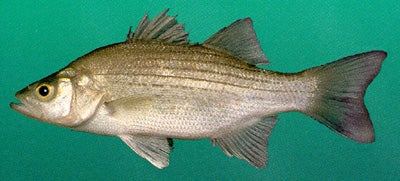SCIENTIFIC NAME:
Morone chrysops
CHARACTERISTICS:
At first glance, white bass resemble small striped bass with faint lateral stripes. But the two can be distinguished by tooth patches on the tongue (one on white bass and two on striped bass). The head on the white bass is fairly small and pointed. The first and second dorsal fins are entirely separate. The first dorsal fin has nine spines, and the second has one spine and 13 to 15 soft rays. The anal fin has three progressively lengthening spines and 11 to 13 soft rays. The back is blue-gray, the sides are silver with six to 10 longitudinal (sometimes faint) stripes, and the venter is white to cream. The dorsal, caudal, and anal fins range from white to dusky. The pectoral and pelvic fins are usually clear, although the latter may have light iridescent blue margins.
ADULT SIZE:
10 to 15 in (254 to 380 mm).
STATE RECORD:
a list of the State Record Freshwater Fish.
DISTRIBUTION:
Morone chrysops is widely distributed in Alabama, but it is not generally abundant except in the Tennessee and Chattahoochee rivers. Duckett (1972) reports that white bass were introduced into Lake Lewis Smith from 1962 through 1965. The first Black Warrior samples were collected in 1949, indicating that the species existed previously in the drainage. White bass are uncommon in the Conecuh River system, but we found none in more than 40 samples collected in the Alabama section of the Choctawhatchee River system from 1991 to 1994. Fishermen visiting from Illinois have told us that northern anglers like to fish for white bass in the Tennessee River near Florence in Lauderdale County.
HABITAT AND BIOLOGY:
White bass inhabit the surface and pelagic (midwater) areas of rivers, reservoirs, and large streams. We have collected them along riprap, downed trees, and other structures below dams. White bass are aggressive predators that feed on gizzard and threadfin shad. Individuals migrate into the lower reaches of large flowing streams to spawn. Males usually precede females. Spawnings between one or more males and a single female usually occur at midwater depths in March and April. Once released and fertilized, eggs drift to the bottom and the larvae hatch in two or three days. Growth is fairly rapid. Etnier and Starnes (1993) report average total lengths of about 8 inches at age one, 14 inches at age two, 16 inches at age three, and 17 inches at age four in the Carter Hill Reservoir in Tennessee.
ORIGINAL DESCRIPTION:
Rafinesque described the white bass in 1820.
ETYMOLOGY:
Morone origin of this genus name is unknown.
Chrysops means golden eye.
The copyrighted information above is from the Fishes of Alabama and the Mobile Basin
RESEARCH:
Auburn University research by Jeffrey Slipke, Richard Lovell and Michael Maceina during 1999 and 2000 in Lakes Mitchell, Jordan, Eufaula and Martin indicate that central Alabama white bass: grow to 230 mm (10 inches) in one year, grow faster in the Coosa River system than in Lake Martin or Lake Eufaula, have more stable populations in Lake Martin, rarely live to age 5, and are cyclical (variable recruitment means that angler catch rates will vary greatly between years, especially in the Coosa River system). This Auburn University research indicated that length limits are currently not needed to manage white bass in these reservoirs.






